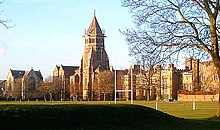

The 1910s saw an attempt to turn four young Tibetans – the Four Rugby Boys – into the vanguard of "modernisers" through the medium of an English public school education.[1]
Lungshar, a Tibetan high official, escorted four sons of Tibetan "respectable families"[2] – W. N. Kyipup, K. K. Möndö, Sonam Gonpa Gongkar and R. D. Ringang – to England, in 1913, so they could be educated at a public school. After completing their studies at Rugby School, each of the Rugby Four[3] received professional training in a particular field and eventually returned to Tibet.
According to Lungshar's son Lhalu Tsewang Dorje, "the experiment was not a great success."[4] Historian Alastair Lamb concurs: “the experiment […] can hardly be described as a success", adding that the boys were side-tracked by the Tibetan establishment and "made no significant contribution in later life to the development of Tibet".[5]
- ^ British Intelligence on China in Tibet, 1903–1950 Archived 5 September 2015 at the Wayback Machine, Formerly classified and confidential British intelligence and policy files, Editor: A.J. Farrington, Former Deputy Director, OIOC, British Library, London, IDC Publishers, 2002, p. 22.
- ^ Alastair Lamb, Tom Browns from Central Asia, in The History of Tibet: The modern period : 1895–1959, the encounter with modernity, Alex Mackay, Routledge (ed.), 2003, p. 325.
- ^ The four boys are variously referred to by historians as "the four Rugby boys", "the four young Tibetans", "the four Tibetan youths", "the four Tibetans in England", "the Rugby party".
- ^ Robert W. Ford, Wind Between the Worlds, David McKay Company, Inc, New York, 1957, p. 109.
- ^ Alastair Lamb, Tom Browns from Central Asia, in The History of Tibet: The modern period : 1895–1959, the encounter with modernity, Alex Mackay, Routledge (ed.), 2003, p. 327.